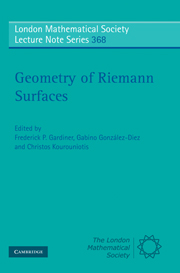Book contents
- Frontmatter
- Contents
- Preface
- Foreword
- Semisimple actions of mapping class groups on CAT(0) spaces
- A survey of research inspired by Harvey's theorem on cyclic groups of automorphisms
- Algorithms for simple closed geodesics
- Matings in holomorphic dynamics
- Equisymmetric strata of the singular locus of the moduli space of Riemann surfaces of genus 4
- Diffeomorphisms and automorphisms of compact hyperbolic 2-orbifolds
- Holomorphic motions and related topics
- Cutting sequences and palindromes
- On a Schottky problem for the singular locus of A5
- Non-special divisors supported on the branch set of a p-gonal Riemann surface
- A note on the lifting of automorphisms
- Simple closed geodesics of equal length on a torus
- On extensions of holomorphic motions—a survey
- Complex hyperbolic quasi-Fuchsian groups
- Geometry of optimal trajectories
- Actions of fractional Dehn twists on moduli spaces
Cutting sequences and palindromes
Published online by Cambridge University Press: 05 May 2013
- Frontmatter
- Contents
- Preface
- Foreword
- Semisimple actions of mapping class groups on CAT(0) spaces
- A survey of research inspired by Harvey's theorem on cyclic groups of automorphisms
- Algorithms for simple closed geodesics
- Matings in holomorphic dynamics
- Equisymmetric strata of the singular locus of the moduli space of Riemann surfaces of genus 4
- Diffeomorphisms and automorphisms of compact hyperbolic 2-orbifolds
- Holomorphic motions and related topics
- Cutting sequences and palindromes
- On a Schottky problem for the singular locus of A5
- Non-special divisors supported on the branch set of a p-gonal Riemann surface
- A note on the lifting of automorphisms
- Simple closed geodesics of equal length on a torus
- On extensions of holomorphic motions—a survey
- Complex hyperbolic quasi-Fuchsian groups
- Geometry of optimal trajectories
- Actions of fractional Dehn twists on moduli spaces
Summary
Introduction
In this paper we discuss several more or less well-known theorems about primitive and palindromic words in two generator free groups. We describe a geometric technique that ties all of these theorems together and gives new proofs of all but the last of them, which is an enumerative scheme for palindromic words. This geometric approach and the enumerative scheme will be useful in applications. These applications will be studied elsewhere [GK3].
The main object here is a two generator free group which we denote by G = 〈A, B〉.
Definition 1.1A word W = W(A, B) ∈ G is primitive if there is another word V = V (A, B) ∈ G such that W and V generate G. V is called a primitive associate of W and the unordered pair W and V is called a pair of primitive associates.
We remark that if W, V is a pair of primitive associates then both WV and WV−1 are primitive and W, WV±1 and V, WV±1 are both primitive pairs.
Definition 1.2Aword W = W (A, B) ∈ G is a palindrome if it reads the same forward and backward.
In [GK1] we found connections between a number of dfferent forms of primitive words and pairs of primitive associates in a two generator free group. These were obtained using both algebra and geometry. The theorems that we discuss, Theorems 2.9, 2.10 and 2.11, can be found in [GK1] and Theorem 2.13 can be found in Piggott [P].
- Type
- Chapter
- Information
- Geometry of Riemann Surfaces , pp. 194 - 216Publisher: Cambridge University PressPrint publication year: 2010
- 2
- Cited by

